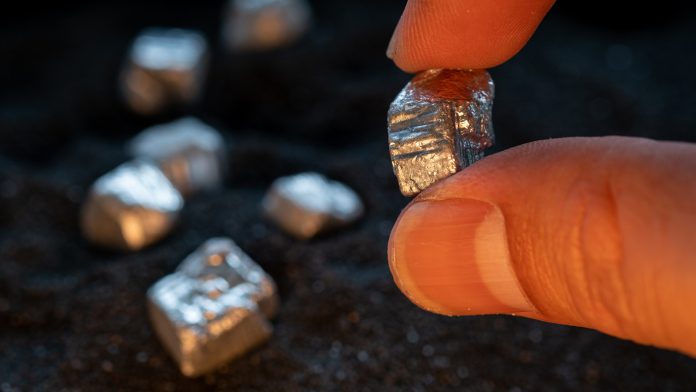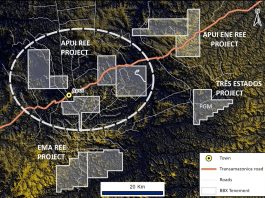In a monumental stride towards reshaping the landscape of rare earth element (REE) production, Brazilian Critical Minerals Limited (BCM) has unveiled its maiden Mineral Resource Estimate (MRE) for the Ema project.
Located in Apuí, Amazon, Brazil, the Ema and Ema East projects, collectively known as the Ema project, share almost identical characteristics with the ionic REE deposits developed over felsic volcanic rocks in southwest China, the world’s largest known ionic clay region.
The MRE unveiling marks a significant milestone not only for BCM but also for Brazil as it positions itself as a formidable contender in the global REE market.
The inferrred MRE, encompassing a staggering 1,017 million tonnes (Mt) @ 793 parts per million (ppm) Total Rare Earth Oxides (TREO), underscores the immense potential harboured within Brazil’s REE-rich territories.
Andrew Reid, BCM Managing Director, commented: “Today’s announcement is very important for the Company and our shareholders as it now sets us on a path towards development.
“This result places Ema as one of the largest ionic rare earths deposits in the world. The team has done a tremendous job in getting such a large MRE defined in less than one year, which now confirms the immense potential of the Ema project in Brazil.
“Not only do we have a massive mineral resource of >1 billion tonnes, but we also have >300 million tonnes at grades close to 1,000ppm, which will assist in generating positive financial cash flow models.
“Opportunities to increase both grade and tonnage remain high due to the extremely conservative global specific gravity (SG) of 1.34, which was applied to the estimated volumes. Additional deeper, less weathered samples from the higher-grade horizon are expected to result in significantly higher SGs.
“With only 46% of the total area drilled, the team is confident of increasing not only tonnages but believes the opportunities to also increase the grade are well founded and will be tested through the next round of drilling commencing over the coming months. BCM is now well on its way to establishing the Company as a global rare earths leader.”
Ema project overview
The Ema ionic REE project emerges as a geological marvel, boasting characteristics akin to the renowned ionic clay deposits found in southwest China—the epicentre of the global REE industry.
Covering a vast expanse of 189 square kilometres of felsic volcanic terrain, these projects have served as the focal point of BCM’s exploration endeavours. The completion of 194 auger holes totalling 2,749 meters stands as a testament to the Company’s unwavering commitment to unlocking Brazil’s REE potential.
Exploration strategy
BCM’s exploration strategy has been strategically anchored on the deployment of auger drilling, a cost-effective and rapid deployment technique that offers unparalleled mobility advantages.
However, the inherent depth limitations of auger drilling, typically reaching depths of around 20 meters, have posed challenges in fully delineating potential higher-grade zones.
Moreover, exploration efforts have primarily been concentrated on hill slopes, with limited drilling in valleys and foothills. Recognising the need to delve deeper into uncharted territories, BCM is poised to embark on a comprehensive exploration campaign targeting these underexplored areas to unveil the full mineralisation potential of the Ema project.
Mineralisation characteristics
A profound revelation lies in the striking similarity in grade and thickness between the enriched zone within Ema East and the primary Ema project.
This enrichment, concentrated at the base of the regolith profile, unveils a tantalising opportunity for targeting superior mineralisation utilising drilling techniques capable of penetrating the underlying saprock zone.
The potential for significant REE enrichment within these zones positions BCM at the forefront of the global REE landscape.
Leach test results
Initial leach test results conducted at SGs have validated the presence of substantial ionically adsorbed clays within the Ema project area.
These tests have showcased high recovery rates for critical Rare Earth Elements, with select elements achieving up to 85% recovery.
The results confirmed the recoveries of the four most essential rare earths: neodymium, praseodymium, dysprosium and terbium.
Such outcomes solidify Ema’s status as one of the largest ionic clay-hosted deposits outside of China, positioning Brazil as a formidable contender in the global REE arena.
Mineral resource estimation
The inferred MRE for the Ema project has been meticulously delineated based on various cut-off grades.
Geological modelling, incorporating the Chemical Index of Alteration (CIA), has enabled precise delineation of mineralised horizons, providing invaluable insights into the projects’ resource potential.
Ema project future plans
Looking ahead, BCM has outlined an extensive plan for future work on the Ema and Ema East projects, encompassing further infill drilling to identify higher-grade zones.
The focus will be on deeper drilling to incorporate these zones into the MRE. Additionally, closer-spaced drilling is proposed to enhance classification and data quality.
Further measurements of specific gravity and metallurgical leaching tests are also on the agenda, both in Brazil and Australia.
The maiden MRE for the Ema project heralds a new era of rare earth element exploration in Brazil.
With promising exploration results and a robust plan for future work, BCM is poised to redefine Brazil’s role in the global REE market.
These projects not only contribute to diversifying the critical minerals supply chain but also position Brazil as a key player in meeting the burgeoning global demand for rare earth elements.








